Homeowners insurance acts as a safety net, providing protection when unexpected disasters strike your dwelling.
A leaky chimney can cause havoc, damaging not only your fireplace but also your peace of mind.
Determining if your insurance covers this mishap requires a close look at your policy’s fine print.
This blog aims to unravel the mystery of home insurance coverage regarding a leaky chimney.
What Is Homeowners Insurance?

Homeowners insurance typically protects against various perils, including fire, theft, and certain natural disasters, ensuring that homeowners can recover from loss without facing devastating financial hardship. It also includes personal property insurance that covers your belongings inside or outside the house.
Chimney repair work is covered by your home insurance. Chimney leaks at the roof level are covered by a standard home insurance cover, although many homeowners are unaware of this.
Understanding how your home insurance policy works is vital to ensuring that your home is adequately covered. This article aims to delve more into the nuances of these policies to prevent you from incurring unnecessary costs for your chimney leak, which may actually be covered by your home insurance.
Understanding the Basics of Homeowners Insurance
At its core, homeowners insurance provides a shield against financial loss by protecting properties and possessions from unforeseen damages and disasters. Policies cover a wide range of incidents, from natural catastrophes like storms and wildfires to risks such as theft and vandalism. This foundational protection allows homeowners to navigate the aftermath of such events with greater ease and security, minimizing the strain on their finances.
Will My Insurance Policy Cover a Leaky Chimney in Oregon?

Deciphering whether your homeowners’ insurance will step in for a chimney leak involves understanding the specific language and coverages within your policy.
For this topic the lynchpin is to distinguish between various incidents, such as whether a “material break of adhesion as a sudden occurrence” directly relates to the damage observed.
Deciphering the Language of Your Insurance Policy
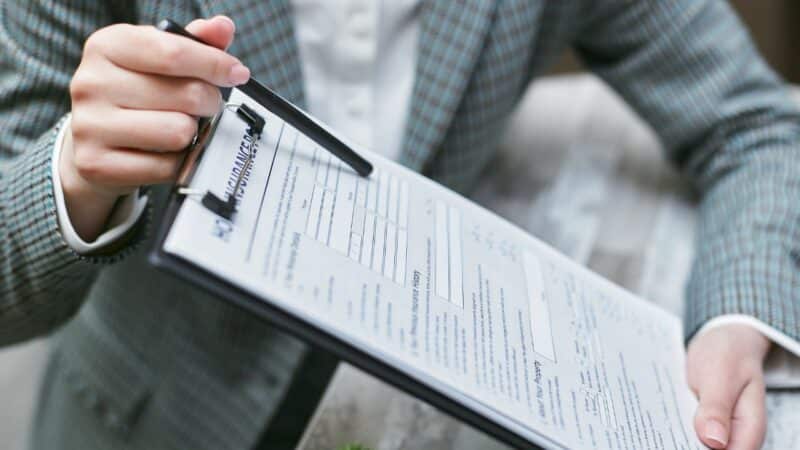
Deciphering the language of your insurance policy is the first crucial step in determining if a leaky chimney is covered. Insurance documents are often filled with industry jargon that can make it challenging to understand what damages are covered and under what circumstances.
It’s essential for homeowners to carefully review their policy or consult with their insurance agent to grasp the nuances of their coverage, especially concerning chimney leaks. Chimney leaks can result from various causes, including weather events (such as storms, lightning, or floods), wear and tear, or structural issues. However, not all of these conditions are covered.
Many homeowners believe that chimney damage is covered only during a chimney fire or lightning strike. For example, if your wood stove or fireplace unexpectedly catches fire due to excessive heat, or if fire escapes the firebox into the chimney flue, your homeowners’ policy will cover the cost.
However, these are not the only causes of loss covered by your homeowners’ policy. Therefore, it’s important to carefully read the policy’s fine print to understand all the details.
Material Break of Adhesion as a Sudden Occurrence

Chimney leaks, especially at the roof level, are covered by homeowners insurance, but many people are unaware of this. Chimney leaks can result from sudden breaks of adhesive materials, which fall under “material break of adhesive” or “sudden occurrence.” This results in the loss of property value.
For example, heavy rains can cause the mortar in your chimney to decay, leading to water leaks. Similarly, strong winds or falling tree branches can also be considered sudden occurrence events.
A standard homeowners policy covers this type of loss, classifying it as a documentable event of storm damage covered by home insurance. Understanding these insurance policies can help you save significantly on home renovations and repairs.
Common Exclusions in Chimney Leak Coverage
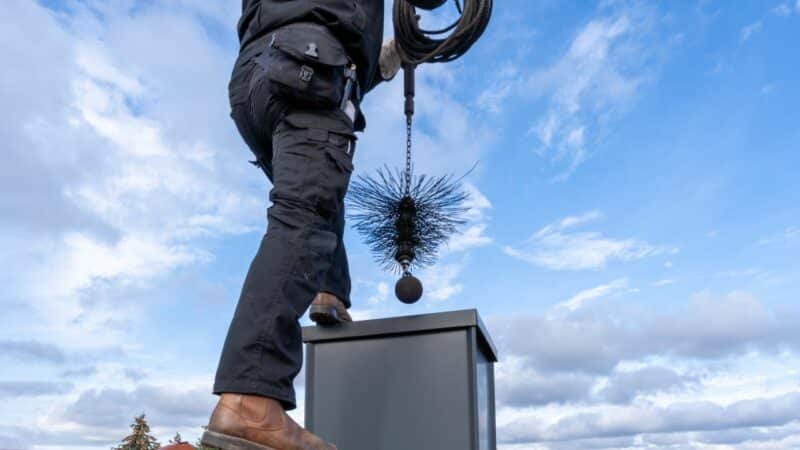
Understanding the specifics of what your homeowners’ insurance policy excludes is just as important as knowing what it covers, especially when it comes to chimney leaks. Typically, policies rule out coverage for damages caused by gradual wear and tear or lack of maintenance. This leaves homeowners responsible for the repair costs of leaks that evolve over time.
Moreover, if an inspection reveals that negligence or failure to upkeep the chimney played a role in the damage, such as improper waterproofing, these factors further solidify the exclusion. All this emphasizes the importance of regular chimney maintenance. For example, your flashing should be watertight.
Hiring a chimney sweep is one way of ensuring that your chimney stays in its best state. Chimney sweeps will identify any cracks or degradation in your chimney and help rectify that early enough. This way, when a chimney leak occurs, it won’t be because of negligence on your part as the homeowner.
Steps to Take Before Filing a Chimney Leak Claim

Before filing a chimney leak claim with your company, it’s crucial to take the necessary steps to ensure a smooth and successful process. Here are some essential steps to follow:
1. Identify the source of the leak: Thoroughly inspect your chimney to determine where the leak is originating from. This could be due to cracked or damaged bricks, deteriorated mortar joints, a faulty chimney cap, or other issues.
2. Document the damage: Take detailed photos and videos of the leak and any resulting water damage inside your home. This documentation will serve as evidence when filing your claim.
3. Mitigate further damage: Take immediate action to prevent additional water from entering your home and causing more damage. This may involve temporarily covering the chimney or placing buckets to catch water.
4. Review your homeowner’s insurance policy: Carefully read through your policy to understand what is covered and what exclusions or deductibles may apply to chimney leaks. This will help you prepare the necessary documentation and information required for your claim.
5. Gather repair estimates: Contact licensed and insured chimney professionals to obtain written estimates for the necessary repairs. These estimates will be crucial in supporting your claim and ensuring you receive fair compensation.
6. Compile documentation: Collect all relevant documentation, including photos, videos, repair estimates, and any receipts for temporary repairs or mitigation efforts.
| Date | Area of Damage | Notes/Observations |
|---|---|---|
| October 5 | Chimney exterior and surrounding roof | Noticed water stains on the ceiling; no recent storms or external damage was observed. |
| October 6 | Interior chimney liner | Evidence of efflorescence and a damp smell inside the fireplace. |
Typical Inclusions and Exclusions for Oregon Homeowners Insurance
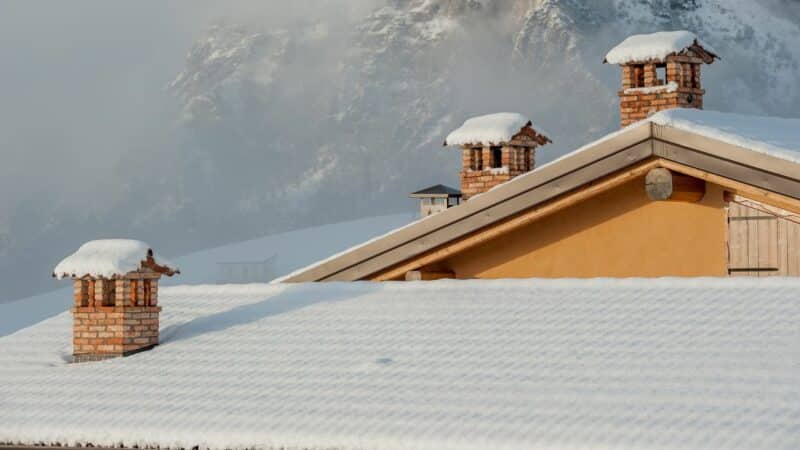
When shopping for home insurance in Oregon, some of the key inclusions and exclusiosn are:
Wildfire: Typically Included
Wildfires are a major risk in Oregon, especially in forested areas. You should always review the details of the policy to determine how much it covers especially if you live in more heavily forested areas. Be mindful of the dwelling coverage limit. You might need to rebuild your entire house after a fire.
Winter Weather: Typically Included
Winter hazards like snow, freezing pipes, and ice dams are usually covered under standard homeowners policies in Oregon. If the damage is caused by a string wind or storm, this is usually also covered. To minimize winter damage, follow best practices which include; maintaining the heat at reasonable levels to avoid frozen, bursting pipes and clearing snow from roofs, if possible, to avoid ice dams and prevent meltwater damage.
Flooding: Typically NOT Included
Homeowners’ policies usually do not cover flood damage. Flood insurance must, therefore, be purchased separately through FEMA’s National Flood Insurance Program. Even areas not designated high-risk may still be at risk. Get quotes for flood insurance to understand your risk. Flooding can occur from rivers overflowing, heavy rains, snow melt, and inadequate drainage. Review flood maps.
Earthquakes: Typically NOT included
Earthquake coverage is usually excluded under a standard home insurance policy in Oregon. Earthquake insurance must be added by endorsement to cover earthquake-related damage like ground shaking, surface cracks, and liquefaction. Deductibles here are typically 10% or more of the dwelling value. There are dollar limits on earthquake claims.
Choosing the Right Chimney Repair Services in Oregon

If you find water coming out of fireplace your next step is to find qualified help. Finding a reliable Portland chimney repair company in Oregon takes research, but hiring the right team is important to protect your chimney, fireplace, and home. When choosing a chimney professional, there are a few key factors to consider:
Licensing
Oregon requires chimney repair companies to hold a Construction Contractors Board (CCB) license. Verify licensing and check ratings or complaints filed against any chimney company you’re considering. Reputable chimney services will gladly provide license info. (Ours is # 202488)
Certifications
Look for chimney contractors certified by the Chimney Safety Institute of America (CSIA). This indicates their technicians have undergone rigorous training and adhere to strict certification standards. CSIA certifications are a sign of continual investment in training and safe standard keeping. Our certifications can be found here.
Experience
Choose a chimney company that has many years of experience specifically with chimney repair work. Their technicians should be well-versed in repairing chimneys made of brick, stone, metal, and other materials. Ask about their experience with chimney rebuilding, restoration, design, and masonry.
Range of Services
Can the company handle all aspects of chimney repair? Look for ones offering services like crown repair, repointing, lining installation, leak repair, top-down chimney rebuilding, and more. An experienced chimney pro should be able to tackle any repair job while the best work on full chimney rebuilding and restoratiosn like here and here.
References
Reputable chimney contractors will provide client references upon request. Speaking with past customers is invaluable in assessing factors like quality of work, timeliness, customer service, and customer satisfaction. Online reviews can also provide insights into a company’s strengths and weaknesses.
Estimated Costs
Get an itemized, written estimate so you understand all anticipated chimney repair costs. Be wary of dirt-cheap quotes that seem too good to be true. Quality chimney repairs take skill, time, and high-grade materials.
Liability Insurance
When hiring a chimney repair company, be sure to verify they carry adequate liability insurance. This protects you if a technician is injured on your property or accidentally causes damage to your home during the repairs. Ask to see proof of the contractor’s liability coverage and confirm their policy has sufficient limits.
Call Portland Fireplace and Chimney for your Insurance Cand for Proper Chimney Repairs!
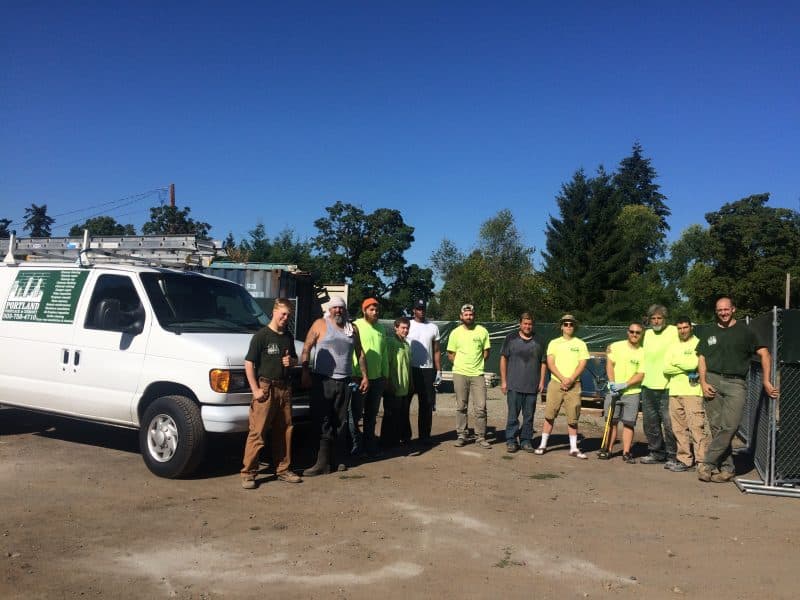
When facing a chimney leak, the expertise of Portland Fireplace and Chimney becomes invaluable not only for comprehensive repairs but also for navigating insurance claims. Their deep understanding of both the construction and insurance aspects ensures that homeowners receive the support needed to handle claims efficiently and effectively. By leveraging their knowledge, homeowners can ensure their claims are thoroughly documented and justified.
The team at Portland Fireplace and Chimney excels in identifying the root causes of chimney leaks and providing effective solutions that prevent future issues. Their approach goes beyond just fixing the immediate problem. It’s also about ensuring the long-term integrity and safety of your chimney and fireplace. This proactive stance can be crucial when dealing with insurance companies, as it demonstrates a commitment to maintenance and risk mitigation.
Working with Portland Fireplace and Chimney means having a partner who stands by your side throughout the insurance claims process, helping to remove the guesswork and stress. Their experience with various insurance providers allows them to offer advice and assistance that can make a significant difference in the outcome of a claim.
FAQs on chimney leak coverage
Does homeowners insurance cover chimney repair?
Yes, it does. However, there are certain circumstances where it doesn’t. For instance, when inspections show that the damage was due to homeowners negligence or lack of proper maintenance.
Does home insurance cover boiler leaks?
Yes, broken boilers are covered under your homeowners insurance but under specific conditions. It is only covered if the damage is caused by a covered peril such as an explosion or natural disaster.
Who fixes leaks around the chimney?
Chimney and fireplace experts. Only choose experts who can prove their expertise and certifications. Don’t make the mistake of hiring a roofer for a chimney repair job, unless they can prove that they qualify for the job.
Does homeowners insurance cover roof leaks?
Yes, homeowners insurance typically covers roof leaks caused by covered perils like severe weather or fallen trees. However, leaks due to lack of maintenance or wear and tear may not be covered. It’s important to review your policy details and comply with any maintenance requirements.
Does home insurance cover leaking pipes?
Most standard homeowners insurance policies cover leaking pipes and the resulting water damage. The coverage may apply whether the leak originated from interior plumbing or exterior underground pipes. However, there may be exceptions or limitations, so it’s best to check your specific policy.
Will homeowners insurance cover a cracked chimney liner?
Homeowners’ insurance policies generally cover cracked or damaged chimney liners, as they are considered part of the dwelling structure. The coverage may include replacing the liner or repairing the crack to prevent further damage. However, some policies may exclude coverage if the damage resulted from a lack of maintenance or normal wear and tear.
What Are the Signs of a Leaky Chimney?
Key indicators of a leaky chimney include (1) the appearance of water stains around the chimney area. This often suggests water penetration that isn’t directly visible, and which can cause further water damage on your property. (2) A persistently damp smell emanating from the fireplace, even when not in use, can also hint at moisture problems within the chimney system. (3) The discovery of efflorescence – a white, powdery substance on chimney bricks – points to water evaporation inside the masonry, which is another telltale sign of a leaking chimney.
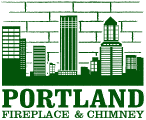
Portland Fireplace and Chimney Inc is your top notch pick for a fireplace and chimney company in the greater Portland metro area.

